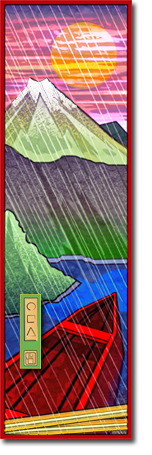On The Way: The Daily Zen Journal
The Meditations of a Bodhisattva Part 2
Kamalasila (8th c)
The four states
Once the mind is made one pointed and more supple, using different meditative objects, the bodhisattva attains to what are called formless meditations. One becomes filled with a feeling of equanimity, discursive thought and reasoning: this is called a state of approach. Once we become detached from sensual craving and filled with enthusiasm and inner tranquility, that is considered the first state.
Next one becomes detached from craving for the level of the first state, free of discursive thought and reasoning, yet still filled with enthusiasm and inner tranquility: this is called the second state. Once there is detachment from craving for this attainment, filled with pleasure and equanimity, mindful and aware, one enters the third state.
Detachment from craving for the level of the third level, without pleasure and without pain, filled with equanimity and mindfulness becomes the fourth state.
Insight meditation
When the mind is thus firmly fixed upon the meditative object, examine it with wisdom: for it is only where light of knowledge dawns that the seeds of delusion are wholly cast aside. Meditation by itself cannot destroy confusion. One who cultivates meditation, yet does not examine the concept of self, will again be shaken by distraction.
The union of calm and insight

Fixing your mind on the meditative object, examine it with wisdom; the light of knowledge dawns to cast aside confusion. Calm and insight both work together to bring about true knowledge, as the eye sees with the aid of light.
In this stage of meditation we understand reality as it really is: for in this state we examine things with wisdom and no event is perceived as real. This is the highest nonseeing: this is called the effortless state, for there is nothing to see beyond it. It is called tranquil, for all the busy work of the mind has been calmed, that which imposes upon reality the constructs of existence and non-existence.
When we examine the world with wisdom, we see no essence of any existing thing, nor do we impose any construct of existence upon reality, or nonexistence upon reality. We look with this eye of wisdom into the past, present, and future and do not see anything which exists: then how can we negate this and impose the construct of nonexistence?
No other constructs will occur then, for all constructs are included within the universal categories of existence and nonexistence. When the universals do not exist, the particulars do not exist either. This is the highest yoga, which imposes no constructs upon reality.
This is the process by which the bodhisattva should contemplate reality. And should giddiness or depression occur, calm yourself by the process we have discussed. When this knowledge takes the essencelessness of all events as its meditative object, and flows evenly and spontaneously upon it, then we can make perfect the way which brings about the union of insight with calm. Abide there with deep conviction as long as you can, for this is the stage of Practicing with Conviction.
The return to the world
When you wish to arise from this state of meditation, before uncrossing your legs, consider: All these events, from the absolute point of view have no essence; yet they are still here in conventional reality. As we read in scripture:
“How is a bodhisattva skilled in selflessness? One looks upon form with true wisdom, and looks upon feeling, and idea, and motive, and perception: and when looking upon form, does not see its occurrence, nor its existence, nor its cessation. And thus it is from the absolute point of view, with wisdom which abides in nonoccurrence; but it is not so in everyday life.”
People with the minds of children wrongly insist that things are real, so they wander in this world, and experience all its many sufferings; and the meditator should awaken his great compassion and consider: When I attain omniscience, let me awaken them to the true nature of things.
This then is the way of the bodhisattvas, which brings about the union of wisdom and means: for though they see the highest reality, they don’t cut themselves off from conventional reality; nor cut themselves off from their reality. The bodhisattva sets out to serve the aim of beings, led by great compassion, and without delusion.
“What is the spiritual practice of a bodhisattva? All the activity of the body, and all the activity of speech, and all the activity of mind: all of it is undertaken out of regard for beings, because it is preceded by great compassion. It is under the sway of compassion, and it springs from hope for the welfare and happiness of all beings. One who hopes for the welfare of the world thinks: Let me undertake spiritual practice, that I might bring welfare and happiness to all beings.
“See the aggregates as like a magic show, but do not wish to disown the aggregates; see the senses like a poisonous snake, but do not wish to disown the senses; see sensory awareness as like an empty village, but do not disown sensory awareness as you work for the welfare of the world.
“See form as a heap of foam, but do not renounce the magical creation of bodies of form; see feeling as like a bubble, but still set forth to attain the pleasures of meditation; see ideas like an illusion, but still conceive of attaining the knowledge of a Buddha. See motive as a hollow reed, but still aspire to attain the qualities of Buddhahood; see perceptions like a magic show, but still seek to attain the activity of body, speech, and mind which springs from knowledge.”
Kamalasila (8th c)
Excerpted from The Buddhist Experience; sources and interpretations translated by Stephan Beyer 1974




Sometimes we are given too much to know what to do with it….sometimes we are given so little, we sit bewildered if we are proceeding “correctly.” So, while not wanting to think about “progress” too literally, here we have a discussion of ever deepening states of mind/spirit based on progressing states or levels resulting from meditation. The message includes that of moving on, detachment from the attainment of the prior state itself. Since enlightenment is not a static attainment but an ever deepening experience, part of what’s required is to let go of what we think we “understood” or “saw” to make room for ever broadening vision.
Next the exquisite teaching of walking a life of balance of a bodhisattva is beautifully communicated. For what good is the realization of the Absolute if we can no longer function in the shared reality?
“This then is the way of the bodhisattvas, which brings about the union of wisdom and means: for though they see the highest reality, they don’t cut themselves off from conventional reality; nor cut themselves off from their reality. The bodhisattva sets out to serve the aim of beings, led by great compassion, and without delusion.”
Once again compassion is the steering mechanism across the river of life. How could one know how to help without the wisdom of meditation, and what enlightenment would be complete without the vow to help all others enmeshed?
Returning,
Elana